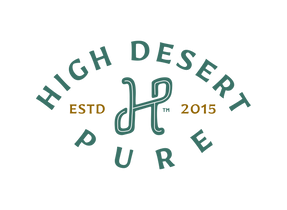Does CBD Show Up On A Drug Test? (A Non-Hyped Explanation)
If you’re getting curious about CBD, you may start to ask yourself: Does CBD show up on a drug test? It’s one of the most common questions we get, and if you’re wondering, you’re not the only one.
According to Statista, CBD product sales in the US have doubled in the past four years alone. Consumers are turning to CBD in the hopes that it can help promote wellness and combat a number of ailments, and the market has responded enthusiastically. With so many products flooding the shelves, it can be hard to know what to look for—and what to avoid.
That’s why we’re here to answer your most common questions about cannabis, drug testing, false positives, and how to get CBD products you can trust.
Does CBD Show Up On Drug Tests? (It Can, But It Shouldn’t)
Does CBD show up on a drug test? The short answer—no. Breathe a sigh of relief.
The long answer is slightly more complicated, but don’t worry. We’ll dive into it together.
When you have to do a drug test for cannabis, the test is looking for THC, not CBD. CBD is legal in the United States, so even if you live in a state or have a job that prohibits you from consuming THC, CBD tends to be a safe bet.
Are there cases where CBD does show up on a drug test? Yes, but only very rarely and in specific cases—usually when something squirrely is going on. Throughout this article, we’ll dive into those exceptions so you can feel confident going into a drug test.
Cannabis In A Nutshell
Before we get ahead of ourselves—what’s cannabis?
Cannabis is a plant of many names. Marijuana, pot, weed, ganja, reefer—it’s all cannabis. Hemp is a specific variety of cannabis with little to no THC.
As of the passage of the 2018 Farm Bill, hemp is legal in the US, and cannabis with THC is legalized on a state-by-state basis. In some places, it’s legal only for medicinal purposes, and in other states (like Oregon and California), it’s legal recreationally as well.
Wait—what’s THC? We’re so glad you asked! It’s a chemical compound contained in cannabis. CBD is another one of those chemical compounds, as are CBN and CBG. So what do these compounds do?
The Difference: THC vs. CBD
So what’s the difference between CBD and THC? They’re both chemical compounds—called cannabinoids—from the cannabis plant, but what about their effects?
Cannabinoids interact with our bodies through the endocannabinoid system. All vertebrates have an endocannabinoid system—there’s one in every human body. This system is a network of receptors that regulate things like pain, appetite, and memory. When your body detects cannabinoid molecules, it amplifies the work the system is already doing. There’s much we still don’t know about the endocannabinoid system, but it’s thought that these interactions are the reason people associate cannabis with feelings like “the munchies” and pain relief.
Because THC causes that psychoactive “head high,” its effects can seem obvious. The effects of CBD might seem more subtle. Though CBD also interacts with the endocannabinoid system, it doesn’t give you a “head high.”
Here’s an overview of some of the differences between cannabidiol (CBD) and THC (tetrahydrocannabinol):
| CBD | THC |
| No psychoactive effects | Psychoactive effect |
| Comes from cannabis or hemp plants | Comes from cannabis plants |
| Legally available nationwide | Medical cannabis containing THC is legal in 37 states; recreational cannabis is legal in 18 states |
| Approved by the Food and Drug Administration for treatment of epilepsy and Dravet syndrome in the drug Epidiolex | Not yet approved by the FDA in any specific medications |
| Available in topicals, gummies, edibles, oils, and vapes | Available in topicals, gummies, edibles, oils, and vapes |
| Currently in scientific studies and clinical trials to better understand potential health benefits and effects on seizures, blood pressure, chronic pain and neuropathic pain, and more | Currently in scientific studies and clinical trials to better understand potential health benefits and effects on seizures, blood pressure, chronic pain and neuropathic pain, and more |
| Will not show up on a drug test | Will show up on a drug test |
Compare two lotions, one made with hemp (just CBD) and one made with both CBD and THC:
The hemp lotion, on the left, is available for purchase online. The lotion with THC, on the right, is only available for purchase from a cannabis dispensary in Oregon or California. Each state has a warning symbol that must appear on any cannabis product for sale in a dispensary—in Oregon, it’s that red symbol on the bottom of the lotion label. For hemp products solid within Oregon dispensaries, they will be labeled with a blue symbol.
The 3 Major Types Of CBD Products
You may see folks try to divide CBD products into three major types—full spectrum, broad spectrum, and isolate. Some companies are also throwing “ultra broad spectrum” into the mix. Unfortunately, these terms can be a bit vacuous and misleading.
There’s no legal definition for what it means to be “full spectrum” or “broad spectrum,” and most of the sites out there that offer explanations seem to be regurgitating the same tepid information. Interestingly, sunscreen companies also use the terms “full spectrum” and “broad spectrum” (albeit implying a different meaning), and in 2011, the FDA stepped in to regulate how manufacturers were allowed to label their products.
However, until the FDA steps in here to regulate cannabis company practices, let’s take a peek at how most companies are using these terms—and what it might mean for any drug tests you take.
To get a sense of what sorts of CBD products are out there, check out this list of CBD lotions—and take a look at how different companies describe the CBD in their products.
Full Spectrum – Has THC?
Back when we started making our products, no one was using the term “broad spectrum.” People mostly just talked about the difference between full-spectrum products and products made using isolate.
Basically, full-spectrum CBD oil is extracted from the cannabis plant in a way that maintains other natural compounds (like terpenes). It’s thought that CBD is more effective when helped out by these other compounds. This process is called “the entourage effect.” CBD isolate is just CBD—no other bits and bobs from the cannabis plant. Isolate is sometimes branded as “the most pure CBD,” which sounds good in theory, but it’s a bit like taking a vitamin A pill instead of eating a carrot—yes, you’re getting the vitamin, but you’re also missing out on a lot of other stuff.
Now that people have started marketing their products as “broad spectrum,” articles have started popping up differentiating full-spectrum products from broad-spectrum products in a way that seems, frankly, weird. Broad-spectrum products, these companies claim, have all the natural compounds of cannabis but no THC.
This seems to imply that full-spectrum products do have THC and are skating just barely under the legal limit. There’s a wave of articles talking about how full-spectrum products contain THC, and thus, will show up on drug tests, but this is just… not true.
Check out these test results from our CBD lotion. It’s made using full-spectrum cannabis oil:
This means that in every gram of lotion, there are 14.3 mg of CBD, and in every bottle of lotion, there are 1,430 mg of CBD. “<LOQ” means “less than the limit of quantification,” which means that the amount of THC present in a bottle of our lotion was lower than this third-party laboratory could quantify. You could eat this bottle of lotion (I mean, please don’t, but if you did) and you would not have enough THC in your system to fail a drug test.
Is it possible that some company out there is making a “full-spectrum” product that sneakily has a few milligrams of THC in it? Yeah. But it’s also possible that some company is doing that with a product labeled “broad spectrum,” because, again, these terms are not legally enforceable. The only thing that’s enforceable is that a CBD product must have less than 0.3% THC. But whether you’re buying a full-spectrum, broad-spectrum, or isolate-based product, you should just check the lab test results for that information.
As much as we appreciate you reading our blog (and, really, we do!), please be wary of getting all your information about cannabis products from people who sell cannabis products. The information these sites provide tends to be very circular and isn’t necessarily written by people who have experience with the chemistry or science going on behind the scenes. So when you see something on a label, see if there are any scientific studies about the terms. If not, it might just be a marketing ploy.
How Much THC Affects Drug Testing
Let’s imagine you were consuming a product with THC in it—so, not a lotion, but a tincture or an edible, for example. How much would you need to consume for the THC to show up on a drug test?
According to drugs.com, it depends on your metabolism and the frequency of your cannabis use. If you consume THC just once, it may only be detected in your urine for the next three days. If you consume THC every day, it may trigger a positive reading on a drug test for weeks after you stop. It’s important to remember that just because you don’t feel high—and it doesn’t feel like you still have cannabis in your system—you could still trigger a positive reading on a drug test. This is because when your body breaks down a food, chemical, or drug, it makes metabolites, which can stay in your system for a lot longer than the drug itself. And in a urine test, the laboratory is actually looking for THC metabolites—not the THC itself.
But there are more ways to test for THC than just urine drug tests. Let’s go through them one by one.
I. Saliva Testing
Saliva testing is not a common way to test for THC. You probably don’t need to worry about doing a saliva test as part of a workplace drug testing program. According to Hound Labs, a company that makes breathalyzer devices for detecting cannabis, THC will only trigger a positive in a saliva test within the first 24 hours or so (though, again, it depends on how frequent your usage).
We’re going to say this every time, so bear with us: CBD will not show up on a saliva test.
II. Urinalysis
Most workplace drug screening is done with a urine test. As we mentioned above, a urine test can detect THC for a month after use, though it depends on the frequency and intensity of use.
Ready for the refrain? CBD will not show up on a urine test.
III. Blood Works
Blood works? We sure hope it does! Anyway.
Blood, like urine, can show THC use for a while—about three weeks, Hound Labs says. This is because the THC gets stored in your fat and gets very gradually released back into your body over the course of this time period. Blood draws are pretty extreme screening tests, so we’d be surprised if you had to do one.
Oh! We almost forgot: CBD will not show up on a blood test.
IV. Hair Follicles
Ah, the hair test. This is also an uncommon way to test for marijuana use, which is good, because we think it’s weird. In a hair test, the lab will measure your hair follicle for the presence of THC. Your hair won’t actually start testing positive until seven or so days after you used THC because the hair needs a chance to grow. Unfortunately, you can continue to test positive for THC for a while after—three months, give or take.
And guess what else? CBD will not show up on a hair follicle test.
Possible Reasons To Fail CBD Drug Tests
But is it possible you could fail a drug test when you only consumed—or thought you were consuming—CBD? Okay, fine. Yes. It is possible. It’s extremely unlikely, but it’s possible. Let’s walk through how that might happen.
For starters, you won’t fail a drug test if you’re using a topical—it doesn’t matter whether that topical contains CBD or THC. This is because topically applied cannabis doesn’t pass into your bloodstream, and drug tests measure the presence of cannabis in your urine (and blood).
So let’s assume you’re ingesting your CBD somehow—eating, smoking, or drinking it.
Consumption of THC
Cannabis drug tests are looking for THC, not CBD. CBD shouldn’t show up on a drug test. However, there are always stories floating around in the cultural consciousness about people who swear they got a false positive for cannabis on a drug test. There could be a few culprits behind this. First: Sometimes people make mistakes. There’s a chance your test could get bungled, or that the testing center is using an outdated test. Some people have successfully challenged tests performed with gas-chromatography mass-spectrometry which falsely flagged CBD as THC. That said, this type of test is very rare and is getting less common by the year.
There’s a slightly more likely way someone could end up with a positive result for THC after only ingesting CBD products. In the US, a CBD product must contain less than 0.3% THC. If a CBD product was at the uppermost limit of this range, that would mean it contained 3 mg of THC for every 997 mg of CBD. If you took thousands of milligrams of this type of CBD every day, you might eventually accidentally ingest enough THC that it would show up on a drug test. But this sort of dose is quite a bit higher than the standard, and probably not something the average CBD user needs to worry about. Also, even though that’s the limit, most CBD products don’t actually have that much THC in them. Most don’t have any.
Mislabeled Product Information
There’s one more way CBD might trigger a positive result on a drug test. Unfortunately, the cannabis industry isn’t always as transparent as it should be. The precise amount of CBD in any given batch of cannabis tends to vary quite a bit, which means that it always raises our eyebrows when we see tinctures or topicals with potency numbers (for example, “1000 mg of CBD”) pre-printed on the container. There’s no way to predict down to the milligram how much CBD will be in this product until it’s made and tested. When you look for a CBD product, make sure the company provides third-party lab testing results on its website.
Without these testing results, you can’t know for certain how much CBD is in your product—or how much THC. If the THC figure is 0.3%—or, even worse, higher than that—you’ll know to tread carefully. If the CBD figure is much lower than what’s promised on the label, you’ll know you’re being ripped off.
This is why we put all of our third-party lab test results online. You should be able to know with certainty how much CBD your product has—and if it contains trace amounts of THC. View the product’s certificate of analysis so you can check for yourself for levels of THC, CBD, and other cannabinoids. Only buy from companies that have this kind of transparency policy.
Conclusion
In short, drug tests are looking for THC, not CBD. Does CBD show up on a drug test? Nope. Whether it’s a hair follicle test, a mouth swab, a urine test, or a blood test, it’s not looking for CBD. It’s looking for THC. Furthermore, most jobs seem to be moving away from testing for THC, so it’s getting less and less likely that you’ll need to worry about it in the future.
We hope you’re feeling more confident about being able to use CBD products without fear of getting a positive drug test result. If you are, why not check out our 1000 mg CBD tincture? We promise awesome quality CBD, totally THC-free.



